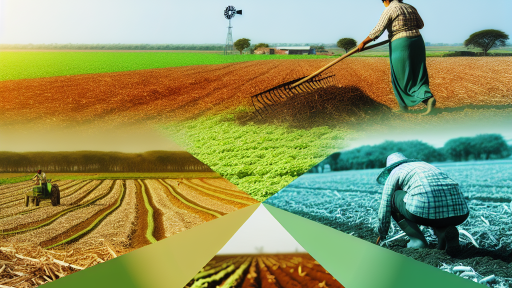Introduction to Carbon Sequestration and Its Importance for Farmers
Carbon sequestration is the process of capturing and storing carbon dioxide.
This practice plays a critical role in combating climate change.
Farmers can implement various strategies to enhance carbon sequestration on their land.
Ultimately, these strategies can lead to more sustainable agricultural practices.
Benefits of Carbon Sequestration for Farmers
Implementing carbon sequestration can improve soil health significantly.
Healthy soil retains more moisture and nutrients, benefiting crop yields.
Additionally, farmers can enhance their land’s productivity over time.
This approach can reduce dependency on chemical fertilizers.
Environmental benefits also include reduced greenhouse gas emissions.
Economic Incentives and Support
Farmers adopting carbon sequestration strategies may qualify for financial incentives.
Government programs often fund sustainable agriculture practices.
Additionally, carbon credits can provide another revenue stream.
These economic benefits encourage farmers to prioritize carbon sequestration.
Implementation Strategies
Various methods are available for farmers to implement carbon sequestration.
Cover cropping is one effective practice to start with.
Transform Your Agribusiness
Unlock your farm's potential with expert advice tailored to your needs. Get actionable steps that drive real results.
Get StartedIt helps improve soil structure while capturing carbon dioxide from the atmosphere.
No-till farming is another method that minimizes soil disturbance.
Agroforestry can also contribute significantly to carbon storage.
Significance of Embracing Sustainable Practices
By adopting carbon sequestration methods, farmers can lead the way in sustainability.
This approach not only combats climate change but also enhances farm resilience.
Farmers have the opportunity to play a crucial role in fostering a healthier environment.
Embracing these practices can ensure productive farming for future generations.
Understanding Soil Carbon Sequestration
What is Soil Carbon Sequestration?
Soil carbon sequestration involves capturing and storing atmospheric carbon dioxide in the soil.
This process enhances soil health and increases agricultural productivity.
It also plays a crucial role in mitigating climate change.
Techniques for Implementing Soil Carbon Sequestration
Farmers can adopt various techniques to enhance carbon sequestration.
One effective method is to increase organic matter in the soil.
This can be achieved through cover cropping.
Cover crops improve soil structure and prevent erosion.
Another technique is reduced tillage.
Minimizing soil disturbance preserves carbon stores in the ground.
Farmers might also consider agroforestry practices.
Integrating trees on farmland can significantly sequester carbon.
Benefits of Soil Carbon Sequestration
Implementing carbon sequestration offers numerous benefits to farmers.
Firstly, it enhances soil fertility and boosts crop yields.
This practice also improves resilience against extreme weather events.
Moreover, healthy soils can retain more water.
This is particularly beneficial in drought-prone areas.
Additionally, carbon sequestration can lead to increased biodiversity.
Showcase Your Farming Business
Publish your professional farming services profile on our blog for a one-time fee of $200 and reach a dedicated audience of farmers and agribusiness owners.
Publish Your ProfileEconomic Incentives
Farmers may also find economic incentives in carbon sequestration.
Many programs offer financial rewards for adopting sustainable practices.
This can create additional revenue streams for farmers.
Furthermore, carbon credits can be sold to other industries.
This innovative approach generates income while promoting sustainability.
Cultivating Community Engagement
Farmers should consider engaging with their communities about carbon sequestration.
Sharing knowledge and practices enhances local sustainability.
Additionally, collaboration fosters collective action toward climate goals.
Cover Crops: Enhancing Soil Health and Sequestering Carbon
What Are Cover Crops?
Cover crops are plants grown primarily for soil benefits.
Farmers use them to cover the soil during times of fallow.
They prevent soil erosion and improve nutrients.
Benefits of Using Cover Crops
Cover crops offer numerous advantages for farming systems.
First, they improve soil structure and health.
Additionally, they help retain moisture in the soil.
Moreover, they can suppress weeds effectively.
This leads to reduced reliance on herbicides and pesticides.
Types of Cover Crops
Several types of cover crops exist, each with unique benefits.
- Legumes, such as clover and peas, fix nitrogen in the soil.
- Grasses, like rye and oats, provide excellent ground cover.
- Brassicas, such as radishes, help break up compacted soil.
Implementing Cover Crops in Farming
Implementing cover crops is a straightforward process.
Farmers first select appropriate species for their region.
Next, they prepare the soil for seeding the cover crops.
After that, they manage the cover crops before main crops are planted.
This includes controlling their growth and terminating them as needed.
Monitoring and Adjusting Practices
Regular monitoring ensures effectiveness of cover crops.
Farmers should assess soil health and crop yields annually.
Based on results, adjustments can be made to cover crop practices.
Such adaptations maximize benefits for both soil and crop production.
Learn More: Crop Rotation To Boost Soil Health Naturally
Agroforestry Practices
Integrating Trees into Farming
Integrating trees into farming practices enhances carbon storage capabilities.
This method combines agricultural production with forestry elements.
Farmers can plant trees alongside crops or pasture areas.
This practice promotes biodiversity and improves soil quality.
Moreover, it can provide additional income sources.
Benefits of Agroforestry
Agroforestry offers numerous ecological benefits.
Firstly, it increases carbon sequestration potential.
Secondly, it reduces soil erosion effectively.
Furthermore, it improves water retention in the soil.
This approach can enhance crop yields over time.
Choosing Tree Species
Selecting the right tree species is crucial for success.
Farmers should consider native species for maximum benefit.
These species often adapt better to local conditions.
Showcase Your Farming Business
Publish your professional farming services profile on our blog for a one-time fee of $200 and reach a dedicated audience of farmers and agribusiness owners.
Publish Your ProfileConsulting with local agricultural extensions can provide valuable guidance.
Additionally, farmers should focus on trees that yield marketable products.
Implementation Strategies
Successful implementation requires careful planning.
Farmers should start with small pilot projects.
This allows observation of environmental and economic impacts.
Furthermore, they should develop a long-term management plan.
Monitoring and adjusting practices will ensure sustained benefits.
Collaborative Efforts
Collaboration with local organizations can enhance agroforestry success.
Farmers can gain access to resources and information.
Networking with other farmers encourages idea sharing.
Such connections can lead to cooperative marketing of products.
Engaging in community workshops can broaden knowledge and skills.
Delve into the Subject: Crop Rotation and Carbon Sequestration Strategies
Reduced Tillage: Methods and Impacts on Carbon Sequestration
Understanding Reduced Tillage
Reduced tillage minimizes soil disturbance during planting.
This method promotes better soil structure and health.
Farmers can enhance carbon sequestration through this practice.
Moreover, it reduces erosion by maintaining the soil’s integrity.
Consequently, soil retains moisture more effectively.
Methods of Implementing Reduced Tillage
Farmers have several options for reduced tillage strategies.
Conservation tillage is one popular approach.
This involves leaving crop residues on the field.
Additionally, no-till farming eliminates disturbance altogether.
Moreover, strip-tillage allows for targeted soil preparation.
Benefits of Reduced Tillage
This practice significantly improves carbon storage in soil.
It enhances microbial activity, promoting nutrient cycling.
Farmers often notice increased yield stability over time.
Furthermore, reduced tillage contributes to mitigating climate change.
It offers long-term sustainability for agricultural lands.
Challenges of Reduced Tillage
While reduced tillage has several benefits, challenges exist.
Weeds may become more prevalent without conventional tilling.
Farmers might need to adapt their pest management strategies.
Additionally, initial investment costs can be a hurdle.
However, many farmers find long-term savings outweigh these costs.
Successful Implementations and Case Studies
Successful examples demonstrate the viability of reduced tillage.
Emma from Green Valley Farms implemented no-till methods and witnessed a 30% increase in soil carbon levels.
Additionally, Liam’s Farm adopted strip-tillage with positive results.
These real-world examples encourage wider adoption of reduced tillage.
Farmers can learn from their peers to implement effective practices.
You Might Also Like: Sustainable Farm Layout Techniques And Best Practices
Livestock Management Strategies for Improved Carbon Capture
Enhancing Pasture Management
Managing pastures effectively increases carbon sequestration in soil.
Showcase Your Farming Business
Publish your professional farming services profile on our blog for a one-time fee of $200 and reach a dedicated audience of farmers and agribusiness owners.
Publish Your ProfileImplement rotational grazing to allow grasslands to recover.
Climatic conditions affect grass growth rates significantly.
Consider multi-species grazing to enhance biodiversity.
Additionally, employ techniques that promote root growth.
Manure Management Practices
Efficient manure handling can contribute to reduced greenhouse gas emissions.
Utilize composting methods to turn manure into a valuable resource.
Composted manure improves soil structure and fertility.
Incorporate manure into the soil promptly after application.
This practice minimizes nutrient runoff and emissions.
Breed Selection for Low Emission Livestock
Choose breeds that exhibit lower methane emissions.
Research shows that certain breeds digest feed more efficiently.
Promoting these breeds decreases the overall carbon footprint.
Collaboration with local universities can aid in breed selection.
Additionally, provide nutrition tailored to specific livestock needs.
Use of Cover Crops
Cover crops can significantly improve soil health and carbon storage.
They prevent erosion and enhance soil organic matter.
Planting legumes as cover crops can fix nitrogen in the soil.
This reduces dependence on synthetic fertilizers over time.
Rotate cover crops to break pest cycles and maintain soil fertility.
Integrating Technology in Livestock Operations
Technology enhances livestock management through data analysis.
Use sensors to monitor soil health and moisture levels accurately.
Implement applications that track livestock emissions effectively.
These tools can highlight areas needing improvement.
Training staff on technology use ensures successful implementation.
Uncover the Details: No-Till Farming To Enhance Soil Regeneration

Measuring and Monitoring Carbon Sequestration on Farms
The Importance of Measurement
Measuring carbon sequestration is crucial for farmers.
It helps assess the effectiveness of implemented practices.
Accurate measurements can lead to better management decisions.
Moreover, these measurements can contribute to climate reporting.
Methods of Measurement
Farmers can use various methods to measure carbon levels.
For instance, soil sampling provides direct insights into carbon content.
Remote sensing techniques offer a broader perspective.
Using drones can enhance accuracy and efficiency in data collection.
Monitoring Practices Over Time
Regular monitoring is necessary to track changes in carbon levels.
Farmers should establish a schedule for periodic assessments.
Implementing consistent practices ensures reliable data over time.
This process allows for adjusting strategies based on results.
Tools and Technologies
Utilizing technology can streamline the measurement process.
Soyl health tests can quantify carbon in the soil.
Data management software can help analyze collected information.
Showcase Your Farming Business
Publish your professional farming services profile on our blog for a one-time fee of $200 and reach a dedicated audience of farmers and agribusiness owners.
Publish Your ProfileFarmers can invest in sensors to monitor conditions in real-time.
Collaboration and Expertise
Working with agronomists provides valuable insights into measurement techniques.
Collaboration with universities can enhance research and data accuracy.
Engaging with organizations focused on carbon management may offer resources.
Partnerships can facilitate access to funding for monitoring initiatives.
Reporting and Verification
Farmers should familiarize themselves with reporting frameworks.
Adopting standards for carbon credits can provide economic benefits.
Verification processes establish credibility in carbon sequestration claims.
Transparent reporting can improve public and market trust.
Government Incentives and Programs to Promote Carbon Sequestration
Understanding Government Support
Government support plays a crucial role in promoting carbon sequestration practices.
Incentives encourage farmers to adopt environmentally friendly techniques.
Various programs aim to enhance soil health while reducing carbon emissions.
Available Programs and Funding Options
Several government programs provide financial assistance to farmers.
The Conservation Stewardship Program offers payments for sustainable practices.
This program emphasizes soil health and improved water quality.
The Environmental Quality Incentives Program aids farmers in adopting new technologies.
It provides cost-share options for implementing conservation measures.
Farmers can benefit from funds to enhance carbon sequestration efforts.
Tax Incentives for Carbon Sequestration
Tax incentives can significantly impact farmers’ decision-making processes.
Some states offer tax breaks for land dedicated to sustainable practices.
Carbon credits can also be a financial gain through existing markets.
Partnerships with Research Institutions
Collaboration with research institutions enhances program effectiveness.
These partnerships can lead to innovative carbon sequestration techniques.
Farmers gain knowledge and practical guidance through these relationships.
Educational Resources and Workshops
Numerous organizations provide educational resources on carbon sequestration.
Workshops offer hands-on training in sustainable farming practices.
Farmers can connect with experts and share successful strategies.
Leveraging Community Programs
Local community programs often support sustainable farming initiatives.
Community-based projects can promote collective action for carbon sequestration.
Participating in these efforts can enhance farmers’ visibility and appeal.
Case Studies: Successful Implementation of Carbon Sequestration in Agriculture
Success at Hawthorne Farms
Hawthorne Farms implemented cover cropping in their rotation system.
This strategy enhanced soil health significantly.
The farm increased organic matter and enhanced moisture retention.
As a result, carbon levels in the soil rose remarkably.
They measured a 15% increase in soil carbon over three years.
Innovative Practices at Green Earth Agro
Green Earth Agro adopted no-till farming techniques.
This practice minimized soil disturbance and erosion.
Consequently, they retained carbon stocks efficiently.
They observed improved yields alongside carbon sequestration benefits.
The farm became a model for local agricultural methods.
Showcase Your Farming Business
Publish your professional farming services profile on our blog for a one-time fee of $200 and reach a dedicated audience of farmers and agribusiness owners.
Publish Your ProfileTransformative Outcomes at Cedar Valley Ranch
Cedar Valley Ranch focused on agroforestry systems.
This system integrated trees into their farming landscape.
The trees provided shade and reduced soil compaction.
Moreover, they captured significant amounts of atmospheric carbon.
The ranch reported improved biodiversity and crop resilience.
Community Impact Through Shared Learning
Farmers are sharing knowledge through local cooperatives.
This collaboration fosters innovative approaches to carbon farming.
Workshops and training sessions facilitate the exchange of ideas.
As a result, many farmers are adopting similar practices.
Community engagement enhances the impact of these strategies.
Challenges and Considerations for Farmers in Adopting Carbon Sequestration Practices
Understanding Carbon Sequestration
Carbon sequestration involves capturing and storing atmospheric carbon dioxide.
Farmers can implement practices to enhance this process.
Technologies and methods vary, impacting efficiency and cost-effectiveness.
Economic Challenges
Adopting sequestration practices can require significant financial investment.
Initial costs may deter farmers from transitioning to new methods.
Additionally, farmers may face uncertainty regarding the return on investment.
Market volatility can further complicate financial planning for these practices.
Technical Knowledge and Skills
Carbon sequestration requires specific technical knowledge and skills.
Farmers may need training to understand new technologies and techniques.
Access to resources for education is essential but often limited.
Partnerships with experts can bridge this knowledge gap.
Regulatory and Policy Barriers
Local, state, and national policies can influence sequestration practices.
Farmers must navigate complex regulations that govern land use.
Incentives may exist, but they often vary by region and program.
Staying informed about policy changes is crucial for farmers.
Environmental Conditions
Soil type and climate impact the effectiveness of sequestration techniques.
Farmers must assess their land’s limitations before implementing practices.
Moreover, local biodiversity plays a role in the success of these approaches.
Adaptation strategies can help mitigate these environmental challenges.
Long-Term Commitment
Carbon sequestration requires a long-term commitment to be effective.
Farmers must be willing to adopt sustainable practices over time.
This commitment can be challenging amid changing agricultural priorities.
Regular monitoring and adjustment of practices will enhance results.
Community Engagement
Collaboration within local farming communities is essential for success.
Farmers can share best practices and support each other’s efforts.
Building relationships with local organizations can provide additional resources.
Networking fosters knowledge exchange and develops cooperative initiatives.
Additional Resources
Call to Action: Colorado Farmers and Ranchers are Committed to a …
How farmers approach soil carbon sequestration? Lessons learned …




